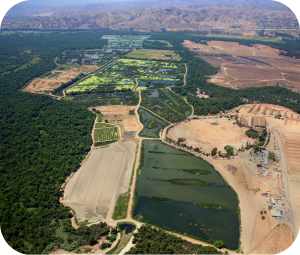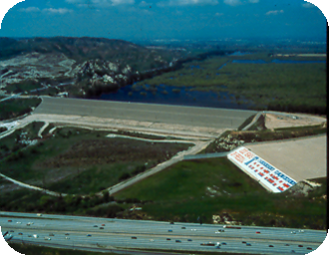President's Message:
Orange County's Planning and Investing for a Not-So Rainy Day is Paying Off
 Shawn Dewane
Shawn Dewane
Governor Brown recently declared California is in a state of emergency due to the
drought. His proclamation gives state water officials more flexibility to manage
supply throughout California under drought conditions. This announcement should
not come as a surprise to Southern Californians being that we live in a semi-desert
region. The average rainfall in the region is 13”; however, rainfall in 2013 was
a mere 3.6”, making it the driest year on record. The declaration has caused a bit
of panic and rightfully so. Cities, businesses and residents rely on water for economic
growth and sustainability, and to preserve public health. Orange County's gross
domestic product is $188.9 billion and its taxable sales are $51.7 billion, making
it the 39th largest economy in the world. So, do we have enough water supplies to
get us through this drought and support our vital economy?
I am pleased to say Orange County will weather these dry conditions better than
other California regions thanks to many of you who have supported investments in
local water infrastructure projects and have made personal commitments to implement
water use efficiency measures in your homes and businesses. Thank you for having
the foresight to make these investments and change water use habits. Despite increases
in our local population, total water demands for our region have remained relatively
stable which shows we are becoming more efficient in our water use. You are about
to see some of the benefits of these past actions, but we are still not completely
out of the woods.
So how good of a position are we in and how long can we hold on? As I have mentioned
before, north and central Orange County are in a unique position having a local
groundwater basin. Groundwater levels are falling quickly, but are still within
their normal historic operating range.
In California, we are expected to experience droughts three out of every ten years.
Knowing this probability, the Orange County Water District (OCWD; the District)
saves reserve funds to prepare for and respond to drought conditions. The District
spent $44 million, from accumulated reserves, in FY 2011-12 purchasing 92,000 acre-feet
(af) (One acre-foot of water is enough to serve two families for a year) of imported
water from the Metropolitan Water District of Southern California (MWD). This helped
to refill the groundwater basin despite receiving less than average Santa Ana River
(SAR) flows due to the drought that year. This strategy put Orange County in a better
position than other regions.
When full, the groundwater basin as a reservoir holds about 500,000 af of water.
We began the year with approximately 210,000 af in storage. If we have another dry
year we expect our storage levels to fall to about 140,000 af as of June 2014. Storage
levels have been this low in the past; however, seawater intrusion from the Pacific
Ocean can become a bigger threat with the lower water levels.
Additionally, there is very little water storage available in case imported water
supplies are significantly reduced. OCWD is currently spending its remaining water
reserve funds – about $22 million – on additional MWD imported water this year while
it is available to help counter the impact of reduced rainfall on the groundwater
basin.

In addition to saving for a not-so rainy day, continuous planning, designing, building
and operations of cost-effective water infrastructure projects have been core functions
of OCWD for more than 80 years. The community's investment in water infrastructure
is fundamental to help our region sustain drought conditions. With community support,
OCWD recently invested $142 million to expand the Groundwater Replenishment System
(GWRS), an award-winning water purification system that takes treated wastewater
from the Orange County Sanitation District and purifies it to meet or exceed drinking
water standards. The expansion, which will be completed in early 2015, will produce
an additional 30 million gallons a day (MGD) and 32,000 acre-feet per year, taking
GWRS production to 100 MGD. In addition to being drought-resistant, GWRS water is
about half the cost of imported supplies and is controlled locally, saving cities
in our service area millions of dollars annually. The expansion will allow stable,
if not more, pumping from the groundwater basin.
Other investments made by local water agencies, such as the Irvine Ranch Water District
and Mesa Water District, to construct wells and treatment plants that access isolated
pockets of groundwater, have also reduced our region's need for imported water.
And MWD's local agency, the Municipal Water District of Orange County, has implemented
water conservation programs that have helped make the region more efficient with
the supplies we receive.
While the GWRS, successful groundwater management, local infrastructure and conservation
have made the region significantly less vulnerable to drought compared to other
cities in California, we need to continue to do more to protect and maximize water
supplies not only in Orange County, but throughout California. We need to maximize
water reuse in California and tap into the 1.3 billion gallons of treated wastewater
from our sewer systems that get discharged to the Pacific Ocean every day in Southern
California; we need to continue to practice water-use efficiency year-round, not
just in times of drought; and, we need to explore other possible solutions, such
as ocean desalination and water transfers. Orange County can breathe a little easier
than other communities due to our past efforts, but as weather patterns continue
to become more extreme, we need to keep planning and investing in our water infrastructure
if we want to continue to have a reliable water supply.
Flory Appointed to OCWD Board
Council Member Jan M. Flory, Esq. was appointed to OCWD's Board of Directors
by the Fullerton City Council to represent the city of Fullerton, Division 10, effective
January 22, 2014. Flory replaced Bruce Whitaker who recently served sixteen months
on OCWD's Board. Not a newcomer to OCWD, Flory previously served on the Board
from 1999 through 2002.
Director Flory is a longtime public servant and resident of Fullerton. In November
2012, she was re-elected to the Council. She previously served on it from October
1994 through December 2002 and was the Mayor in 1998-99, and Mayor Pro Tem in 1997-98
and 2001-02. For Director Flory's complete bio, please visit
The OCWD Board of Directors and Service Area Map.
GWRS Honored with U.S. Water Prize
U.S. Water Alliance President Ben Grumbles recently announced Orange County Water
District and Orange County Sanitation District (OCSD) will be recipients of the
2014 U.S. Water Prize. Their joint project, the Groundwater Replenishment System,
was recognized as a global leader in reclamation and reuse. The award-winning project
and its current expansion were lauded as a tremendous effort to reduce regional
water insecurity and recharge precious supplies.
The two public agencies have worked together for more than 30 years and are leading
the way in water recycling and providing a locally-controlled, drought-proof supply
of high-quality water in an environmentally sensitive manner.
The U.S. Water Prize was initiated four years ago by the U.S. Water Alliance to
elevate those organizations with strategies that promote the value of water and
the power of innovating and integrating for “one water sustainability.” OCWD and
OCSD, along with three other winners, will be honored in an awards ceremony on April
7, 2014, at National Geographic headquarters in Washington D.C. To read the complete
award press release, please visit:
U.S. Water Prize Announcement.
Update on OCWD's Ocean Desal Exploration
As part of a working group made up of cities and water districts in Orange County,
OCWD executed a confidentiality agreement in April 2010 to receive information from
Poseidon Resources to study its proposed ocean desalination facility in Huntington
Beach. On June 24, 2013, the OCWD Board of Directors approved executing an amendment
to the agreement, giving OCWD access to additional information to study the economic
feasibility of the project that may lead to a water purchase agreement for the entire
production capacity of the plant.
Currently, OCWD continues to explore the feasibility of ocean desalination in an
ongoing effort to diversify its water portfolio and ensure water reliability. Most
recently, at the January 8, 2014 OCWD Board meeting, staff presented preliminary
information about the proposed desalination project. The report included information
about projected water reliability, project costs, comparisons to imported water
rates, project structure, and impacts the recent coastal commission action may have
on the cost of the project. This preliminary report is currently being reviewed
by the 19 cities and agencies served by OCWD.
Community members are encouraged to review the report and
offer their comments to the Board by February 28, 2014. It can be viewed
at:
Ocean Desalination Exploration and the Ocean Desalination Citizens' Advisory Committee.
Comments and questions may be submitted to oceandesalexploration@ocwd.com. Prior
meeting agendas, reports, studies and press releases may also be found on this site.
Additional data will be posted as it becomes available.
OCWD Expert Appointed to National Research Council (NRC) Committee
OCWD Executive Director of Planning and Natural Resources Greg Woodside was appointed
to serve on the National Academy of Sciences' National Research Council (NRC)
Committee to review the Edwards Aquifer Habitat Conservation Program-Phase 1 (The
Program). The Program was designed to resolve the longstanding conflict between
the federal mandate to protect threatened and endangered species associated with
the Edwards Aquifer, located in south central Texas, and the region's dependence
on the same aquifer as its primary water resource.
The 12-member interdisciplinary NRC Committee will focus on the adequacy of the
body of scientific information used to determine the Edwards Aquifer Habitat Conservation
Plan's (EAHCP) biological goals and objectives. Additionally, it will study
relationships among proposed conservation measures and the biological goals and
objectives. The Committee will perform its review from 2014 to 2018 and produce
three reports.
To read the full press release regarding Woodside's appointment, please visit:
OCWD Expert Appointed to National Research Council Committee.
Prado Open Water Unit Process (POWUP) Wetland Monitoring & Research Program


The District has begun a research project at its Prado Wetlands with the National
Science Foundation-supported Engineering Research Center (ERC) for Re-Inventing
the Nation's Urban Water Infrastructure (ReNUWIt). The POWUP project will test
a new open-water wetlands treatment concept in a larger scale than previously attempted.
The open-water concept has shown promise in smaller scale pilot-testing in the town
of Discovery Bay, located near Stockton, California. The open-water system will
not contain intentionally-planted vegetation and will be operated at a shallow depth
(20 – 30 cm). The system relies on sunlight for photochemical treatment, as well
as the establishment of a biologically-active periphyton community on the wetland
bottom. Periphyton is comprised of a complex community of algae, bacteria, other
microbes, and plant matter. The research will assess the treatment performance of
the open-water system for constituents such as nitrate and trace organics, along
with the associated maintenance requirements. It is hypothesized that the open-water
system can be linked with other types of wetlands to provide a series of unit treatment
processes that collectively provide a broad spectrum of water quality benefits.
An existing pond at Prado has been reconfigured into three open-water cells, each
approximately 800 feet in length by 100 feet in width. The three test cells began
receiving water in November 2013 and can be operated in parallel or in series. Some
background water quality testing will occur this winter while the periphyton layer
develops. District staff will operate the system, assist with onsite water quality
sample collection, and provide some laboratory analysis. The ReNUWIt team will provide
additional laboratory analysis, data review and management, operational guidelines,
and design a suite of online sensors allowing for remote water quality and flow
monitoring. The ReNUWIt ERC is comprised of researchers from Stanford University,
UC-Berkeley, Colorado School of Mines, and New Mexico State University; the District
is also a member of ReNUWIt's Industrial/Practitioner Advisory Board.
OCWD Recognizes 635 Years of Employee Service
OCWD employs 216 people at its facilities in Fountain Valley, Anaheim and the Prado
Wetlands in Corona. It recently recognized 43 of them for five or more years of employment.
Combined, these employees have provided more than 635 years of dedicated service
to the District. OCWD thanks these employees and recognizes their dedication and
commitment, which help the District carry out its mission. Following is a complete
list of those recognized:
35 years: Philip Harrington
30 years: Randy English
25 years: Grisel Rodriguez, Joaquin Ferreyra, Donald Jackson, Michael Markus, Gregory
Wietki, Donna Pike, Mark Yamamoto, Roy Herndon, Timothy Sovich, Steven Clark
20 years: Ken Ishida, Kaukaba Naggar, Lorenzo Jackson, Mick Riopka, Tom Knoell,
Lynn McConnell
15 years: Alex Vue, Laura Liang, Julio Langarica, Darlene Lipinski-Fagan
10 years: Noe Valdez, Tam Nguyen, Matt Buis, Nicole Nguyen, Andre Casasola, Karen
Warren, Rose Wilke
5 years: Gina Ayala, Frank Chavez, Benjamin Lockhart, Kevin O'Toole, James Smith,
Scott Nygren, James Haydock, Juan Ramirez, Julie Combs, Monica Villalvazo, Randy
Fick, Karen Underhill, Michael Centro
Thank you and congratulations to OCWD's service award recipients!
OCWD Employee of the Year
The OCWD employee of the month and year program was established to recognize outstanding
District employees and to acknowledge their contributions to OCWD. The program commends
employees for exemplary work, dedication and innovation. Each month an employee
may be nominated by peers or supervisors to receive the EOM designation. At the
end of the calendar year, all EOMs for the given year are eligible to be voted employee
of the year (EOY); all employees may cast a vote to select the EOY.
Don Houlihan was voted to receive the 2013 EOY and was also the June EOM. As recharge
operations supervisor, Don is responsible for oversight of OCWD's recharge operations,
which include planning for storms and imported water deliveries, coordinating the
movement of water around the District's various recharge operations and conveyances,
and scheduling the cleanings and maintenance of basins at dozens of geographically
diverse locations. Over the past several years, Don has received various promotions
and has assumed challenging responsibilities. His experience, work ethic, and natural
ability to lead have served as a positive example to others.
Don was recognized at the January 22 board meeting. Congratulations Don!
OCWD January 2014 Employee of the Month
Scott Nygren was selected January Employee of the Month. He manages the maintenance
and operational duties of the Prado wetlands. In addition to these responsibilities,
he recently played a significant role in the POWUP Wetland Monitoring and Research
Program. Scott and his staff worked with university professors and graduate students,
possessing limited field experience, to construct the new open-water ponds and implement
the research team's ideas. His enthusiasm, flexibility, and "can-do" attitude
have been invaluable and will continue to serve the project in the operational phase.
Congratulations Scott!
Tours


During the 2013 calendar year, OCWD conducted 192 tours for 3,408 guests. It is
committed to proactive public outreach and education.
The following guests recently toured the GWRS in the month of December: nursing
students from California State University, Fullerton; San Bernardino Valley College
students; staff from the Los Angeles Department of Water & Power and members of
its ratepayer advocate group; Dennis Popp of the Daily Pilot and Lee Ramos; attendees
of the Orange County WateReuse chapter meeting; Dr. Laura Onyango from the University
of New South Wales, Australia; California Water, Parks & Wildlife Committee Chief
Consultant Tina Cannon-Leahy; staff from San Jose-Santa Clara Regional Wastewater
Facility; and staff from WaveCrest Chemical, Inc.
Public tours of the Groundwater Replenishment System are offered at
10 a.m. on the first Friday of every month; reservations are required. Tours may be scheduled for other days of the week, depending on staff availability. To schedule a tour or to request more information, please contact Becky Mudd at (714) 378-3362 or
bmudd@ocwd.com. To schedule a speaker, please contact Rose Wilke at (714) 378-3206 or
rwilke@ocwd.com. You may also visit
www.ocwd.com to schedule these activities online.
CONTACT US
www.ocwd.com
18700 Ward Street
Fountain Valley, CA 92708
(714) 378-3200
info@ocwd.com
You are receiving this email from the Orange County Water District. If you would like to be removed from OCWD's email list, please respond to this email with "Unsubscribe" in the subject line. Thank you.